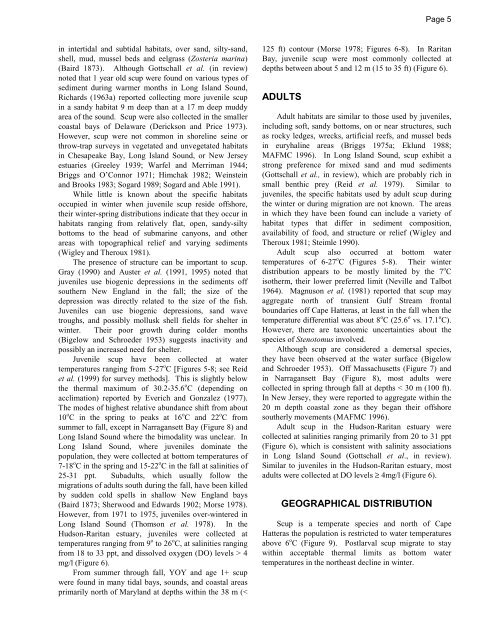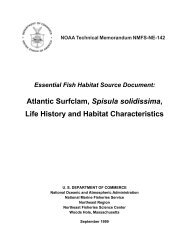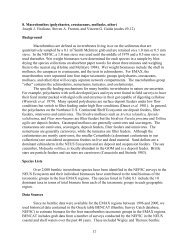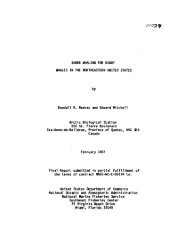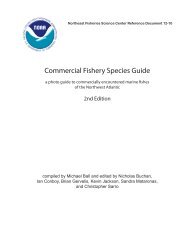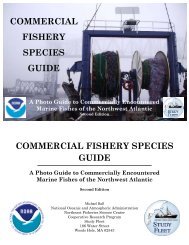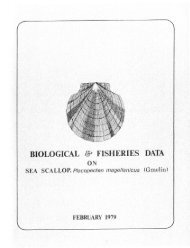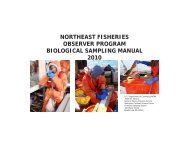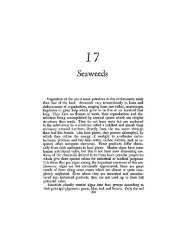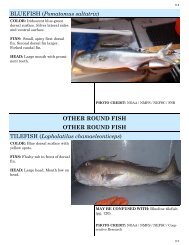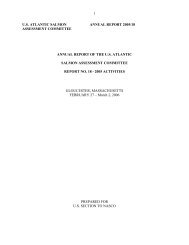Scup, Stenotomus chrysops, Life History and Habitat Characteristics
Scup, Stenotomus chrysops, Life History and Habitat Characteristics
Scup, Stenotomus chrysops, Life History and Habitat Characteristics
You also want an ePaper? Increase the reach of your titles
YUMPU automatically turns print PDFs into web optimized ePapers that Google loves.
in intertidal <strong>and</strong> subtidal habitats, over s<strong>and</strong>, silty-s<strong>and</strong>,<br />
shell, mud, mussel beds <strong>and</strong> eelgrass (Zosteria marina)<br />
(Baird 1873). Although Gottschall et al. (in review)<br />
noted that 1 year old scup were found on various types of<br />
sediment during warmer months in Long Isl<strong>and</strong> Sound,<br />
Richards (1963a) reported collecting more juvenile scup<br />
in a s<strong>and</strong>y habitat 9 m deep than at a 17 m deep muddy<br />
area of the sound. <strong>Scup</strong> were also collected in the smaller<br />
coastal bays of Delaware (Derickson <strong>and</strong> Price 1973).<br />
However, scup were not common in shoreline seine or<br />
throw-trap surveys in vegetated <strong>and</strong> unvegetated habitats<br />
in Chesapeake Bay, Long Isl<strong>and</strong> Sound, or New Jersey<br />
estuaries (Greeley 1939; Warfel <strong>and</strong> Merriman 1944;<br />
Briggs <strong>and</strong> O’Connor 1971; Himchak 1982; Weinstein<br />
<strong>and</strong> Brooks 1983; Sogard 1989; Sogard <strong>and</strong> Able 1991).<br />
While little is known about the specific habitats<br />
occupied in winter when juvenile scup reside offshore,<br />
their winter-spring distributions indicate that they occur in<br />
habitats ranging from relatively flat, open, s<strong>and</strong>y-silty<br />
bottoms to the head of submarine canyons, <strong>and</strong> other<br />
areas with topographical relief <strong>and</strong> varying sediments<br />
(Wigley <strong>and</strong> Theroux 1981).<br />
The presence of structure can be important to scup.<br />
Gray (1990) <strong>and</strong> Auster et al. (1991, 1995) noted that<br />
juveniles use biogenic depressions in the sediments off<br />
southern New Engl<strong>and</strong> in the fall; the size of the<br />
depression was directly related to the size of the fish.<br />
Juveniles can use biogenic depressions, s<strong>and</strong> wave<br />
troughs, <strong>and</strong> possibly mollusk shell fields for shelter in<br />
winter. Their poor growth during colder months<br />
(Bigelow <strong>and</strong> Schroeder 1953) suggests inactivity <strong>and</strong><br />
possibly an increased need for shelter.<br />
Juvenile scup have been collected at water<br />
temperatures ranging from 5-27 o C [Figures 5-8; see Reid<br />
et al. (1999) for survey methods]. This is slightly below<br />
the thermal maximum of 30.2-35.6 o C (depending on<br />
acclimation) reported by Everich <strong>and</strong> Gonzalez (1977).<br />
The modes of highest relative abundance shift from about<br />
10 o C in the spring to peaks at 16 o C <strong>and</strong> 22 o C from<br />
summer to fall, except in Narragansett Bay (Figure 8) <strong>and</strong><br />
Long Isl<strong>and</strong> Sound where the bimodality was unclear. In<br />
Long Isl<strong>and</strong> Sound, where juveniles dominate the<br />
population, they were collected at bottom temperatures of<br />
7-18 o C in the spring <strong>and</strong> 15-22 o C in the fall at salinities of<br />
25-31 ppt. Subadults, which usually follow the<br />
migrations of adults south during the fall, have been killed<br />
by sudden cold spells in shallow New Engl<strong>and</strong> bays<br />
(Baird 1873; Sherwood <strong>and</strong> Edwards 1902; Morse 1978).<br />
However, from 1971 to 1975, juveniles over-wintered in<br />
Long Isl<strong>and</strong> Sound (Thomson et al. 1978). In the<br />
Hudson-Raritan estuary, juveniles were collected at<br />
temperatures ranging from 9 o to 26 o C, at salinities ranging<br />
from 18 to 33 ppt, <strong>and</strong> dissolved oxygen (DO) levels > 4<br />
mg/l (Figure 6).<br />
From summer through fall, YOY <strong>and</strong> age 1+ scup<br />
were found in many tidal bays, sounds, <strong>and</strong> coastal areas<br />
primarily north of Maryl<strong>and</strong> at depths within the 38 m (<<br />
Page 5<br />
125 ft) contour (Morse 1978; Figures 6-8). In Raritan<br />
Bay, juvenile scup were most commonly collected at<br />
depths between about 5 <strong>and</strong> 12 m (15 to 35 ft) (Figure 6).<br />
ADULTS<br />
Adult habitats are similar to those used by juveniles,<br />
including soft, s<strong>and</strong>y bottoms, on or near structures, such<br />
as rocky ledges, wrecks, artificial reefs, <strong>and</strong> mussel beds<br />
in euryhaline areas (Briggs 1975a; Eklund 1988;<br />
MAFMC 1996). In Long Isl<strong>and</strong> Sound, scup exhibit a<br />
strong preference for mixed s<strong>and</strong> <strong>and</strong> mud sediments<br />
(Gottschall et al., in review), which are probably rich in<br />
small benthic prey (Reid et al. 1979). Similar to<br />
juveniles, the specific habitats used by adult scup during<br />
the winter or during migration are not known. The areas<br />
in which they have been found can include a variety of<br />
habitat types that differ in sediment composition,<br />
availability of food, <strong>and</strong> structure or relief (Wigley <strong>and</strong><br />
Theroux 1981; Steimle 1990).<br />
Adult scup also occurred at bottom water<br />
temperatures of 6-27 o C (Figures 5-8). Their winter<br />
distribution appears to be mostly limited by the 7 o C<br />
isotherm, their lower preferred limit (Neville <strong>and</strong> Talbot<br />
1964). Magnuson et al. (1981) reported that scup may<br />
aggregate north of transient Gulf Stream frontal<br />
boundaries off Cape Hatteras, at least in the fall when the<br />
temperature differential was about 8 o C (25.6 o vs. 17.1 o C).<br />
However, there are taxonomic uncertainties about the<br />
species of <strong>Stenotomus</strong> involved.<br />
Although scup are considered a demersal species,<br />
they have been observed at the water surface (Bigelow<br />
<strong>and</strong> Schroeder 1953). Off Massachusetts (Figure 7) <strong>and</strong><br />
in Narragansett Bay (Figure 8), most adults were<br />
collected in spring through fall at depths < 30 m (100 ft).<br />
In New Jersey, they were reported to aggregate within the<br />
20 m depth coastal zone as they began their offshore<br />
southerly movements (MAFMC 1996).<br />
Adult scup in the Hudson-Raritan estuary were<br />
collected at salinities ranging primarily from 20 to 31 ppt<br />
(Figure 6), which is consistent with salinity associations<br />
in Long Isl<strong>and</strong> Sound (Gottschall et al., in review).<br />
Similar to juveniles in the Hudson-Raritan estuary, most<br />
adults were collected at DO levels ≥ 4mg/l (Figure 6).<br />
GEOGRAPHICAL DISTRIBUTION<br />
<strong>Scup</strong> is a temperate species <strong>and</strong> north of Cape<br />
Hatteras the population is restricted to water temperatures<br />
above 6 o C (Figure 9). Postlarval scup migrate to stay<br />
within acceptable thermal limits as bottom water<br />
temperatures in the northeast decline in winter.


